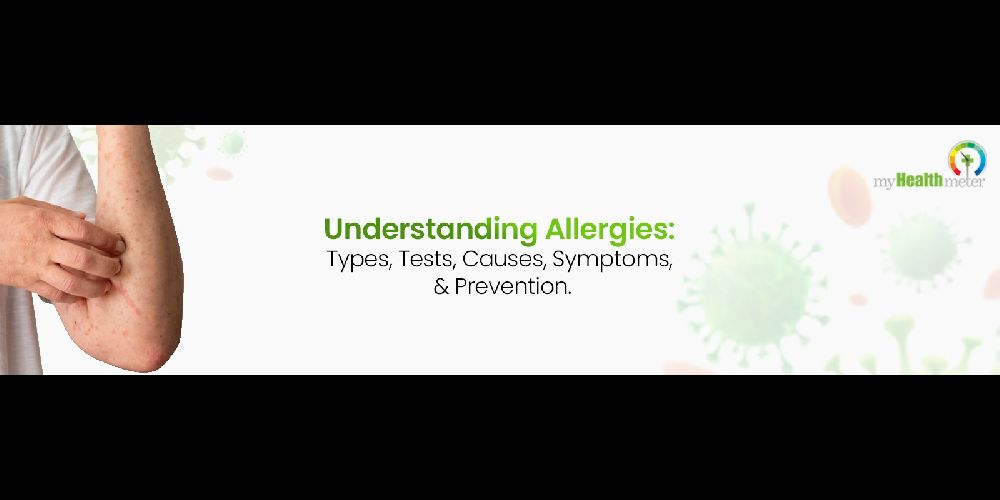Understanding Allergies Types, Tests, Causes, Symptoms, and Prevention
-
December 18, 2023
-
755 Views
Understanding Allergies: Types, Tests, Causes, Symptoms, and Prevention
What are Allergies? Types Common in India
Allergies, immune system reactions to specific substances, can significantly impact daily life. In India, various types of allergies prevail, primarily driven by environmental factors. Environmental allergies are triggered by pollen, dust mites, and pollution. Seasonal allergies are commonplace, often manifesting as hay fever due to the diverse climates. Food allergies are widespread, with nuts, shellfish, and dairy being common triggers. Insect sting allergies, influenced by the abundance of insects, pose a risk, especially during outdoor activities. Drug allergies, caused by medications like antibiotics and pain relievers, are also observed. Skin allergies, including eczema and contact dermatitis, may result from exposure to allergens.
In India, environmental factors like high levels of air pollution contribute significantly to the prevalence of allergies. Seasonal allergies are often exacerbated by variations in temperature and humidity, leading to increased pollen levels. Food allergies are common, with the diverse cuisine incorporating various potential allergens. Insect sting allergies are more prominent in regions with a higher insect population, such as rural areas. Drug allergies can be influenced by the widespread use of certain medications in the healthcare system. Skin allergies may be triggered by exposure to allergens prevalent in the environment or certain skincare products.
Understanding the types of allergies prevalent in India lays the foundation for effective management and preventive strategies. As we delve deeper into causes, symptoms, and prevention in subsequent sections, it becomes apparent that a tailored approach considering regional factors is crucial for addressing allergies in this diverse and dynamic country. This comprehensive understanding will empower individuals to navigate and mitigate the impact of allergies on their health effectively.
Causes and Symptoms of Allergies in India
In India, where a rich tapestry of cultures, climates, and environments coexists, allergies find diverse triggers. Understanding the causes and symptoms of these allergies is paramount for effective management.
Environmental Allergies: The high levels of air pollution, common in urban areas, contribute significantly to environmental allergies in India. Pollen from various flowering plants, combined with dust mites prevalent in homes, can trigger allergic reactions. Symptoms include sneezing, nasal congestion, and itchy or watery eyes. Seasonal variations and diverse climates create an environment where hay fever becomes a widespread concern.
Food Allergies: India's gastronomic landscape, while delightful, can pose challenges for those with food allergies. Nuts, common in many traditional dishes, can lead to severe allergic reactions. Shellfish allergies, prevalent in coastal regions, manifest with symptoms such as gastrointestinal distress, skin rashes, or, in severe cases, anaphylaxis. The diversity of Indian cuisine demands careful scrutiny of ingredients for those with food allergies.
Insect Sting Allergies: Insect stings, a common occurrence in rural areas, can lead to allergic reactions. The higher insect population in these regions increases the risk of exposure. Symptoms may include localized swelling, redness, and itching. In severe cases, individuals may experience difficulty breathing and a drop in blood pressure, necessitating immediate medical attention.
Drug Allergies: The widespread use of certain medications in the Indian healthcare system introduces the risk of drug allergies. Antibiotics and pain relievers are common culprits. Allergic reactions may manifest as skin rashes, itching, or respiratory distress. Awareness and communication with healthcare providers are crucial for minimizing these risks.
Skin Allergies: Exposure to environmental allergens, as well as certain skincare products, can lead to skin allergies. Harsh climatic conditions, combined with allergens in the air, contribute to conditions like eczema and contact dermatitis. Symptoms include itching, redness, and swelling.
Prevention Tips and Conclusion
Preventing allergies in India involves a proactive approach considering the diverse landscape and prevalent allergens. Tailoring preventive measures to individual sensitivities and regional factors is crucial for effective allergy management.
Environmental Allergies:
- Air Purifiers and Clean Living Spaces: In urban areas with high pollution levels, using air purifiers at home can mitigate the impact of environmental allergens. Regular cleaning to reduce dust mites is also essential.
- Monitor Pollen Counts: Stay informed about local pollen counts, especially during peak seasons, and adjust outdoor activities accordingly. This knowledge allows individuals to plan and minimize exposure.
Food Allergies:
- Ingredient Awareness: Given the rich and diverse culinary offerings in India, individuals with food allergies must be vigilant about ingredient awareness. Clear communication about dietary restrictions is crucial, especially when dining out.
- Carry Emergency Medication: For those with severe food allergies, carrying emergency medications like epinephrine injectors is vital to address anaphylactic reactions promptly.
Insect Sting Allergies:
- Protective Clothing: When venturing into areas with a higher risk of insect stings, wearing protective clothing such as long sleeves and pants can reduce exposure.
- Insect Repellents: Using insect repellents, especially in outdoor settings, helps prevent insect stings.
Drug Allergies:
- Communication with Healthcare Providers: Patients should communicate any history of drug allergies to healthcare providers. This information is crucial for prescribing medications that are safe and suitable for the individual.
Skin Allergies:
- Hypoallergenic Products: Using hypoallergenic skincare products can reduce the risk of skin allergies. Checking product labels for potential allergens is essential.
- Moisturize and Protect: Given India's diverse climates, regular moisturizing and protecting the skin from environmental factors can prevent skin allergies.
Understanding and preventing allergies in India require a combination of awareness, adaptation, and communication. A personalized approach that considers both individual sensitivities and regional influences is key. While India's dynamic environment poses challenges, it also offers opportunities for individuals to proactively manage their health and enjoy the richness of its cultural and culinary diversity. By staying informed, taking preventive measures, and fostering open communication with healthcare providers, individuals can significantly reduce the impact of allergies on their daily lives, contributing to a healthier and more vibrant lifestyle.Top of Form.





